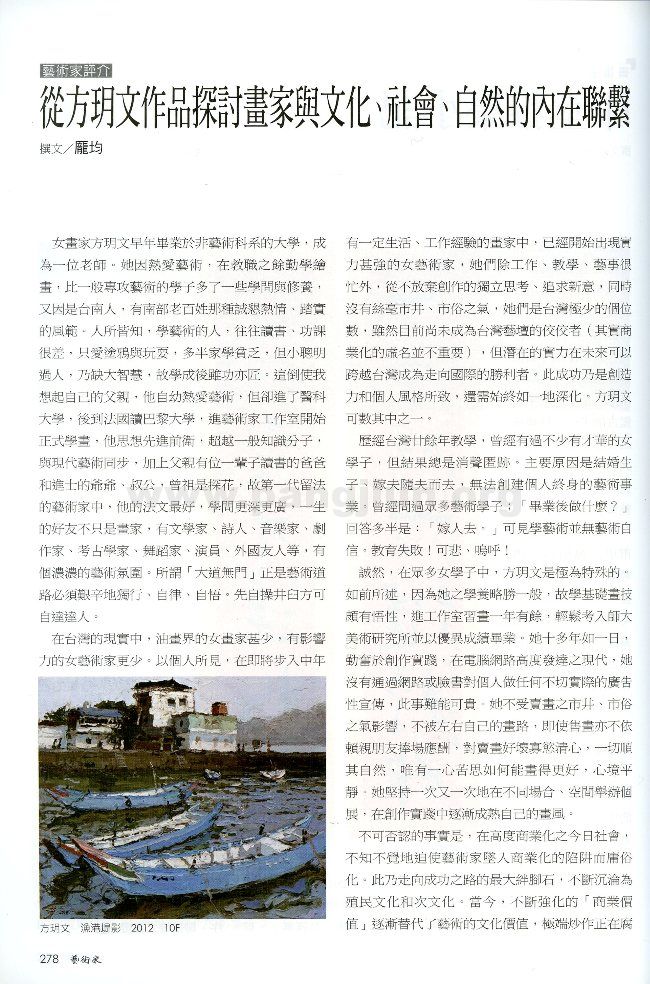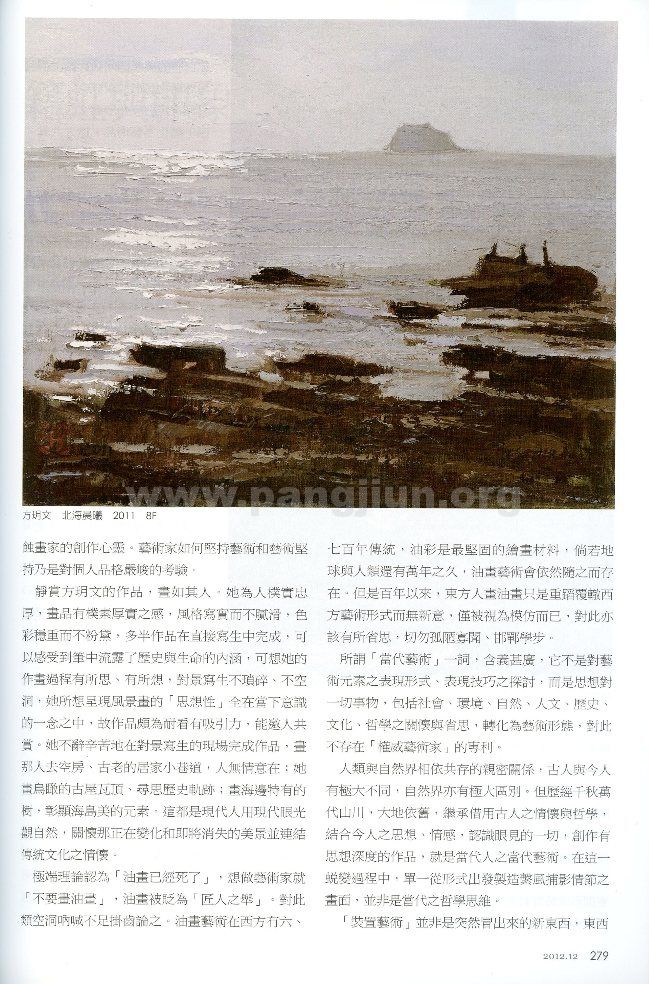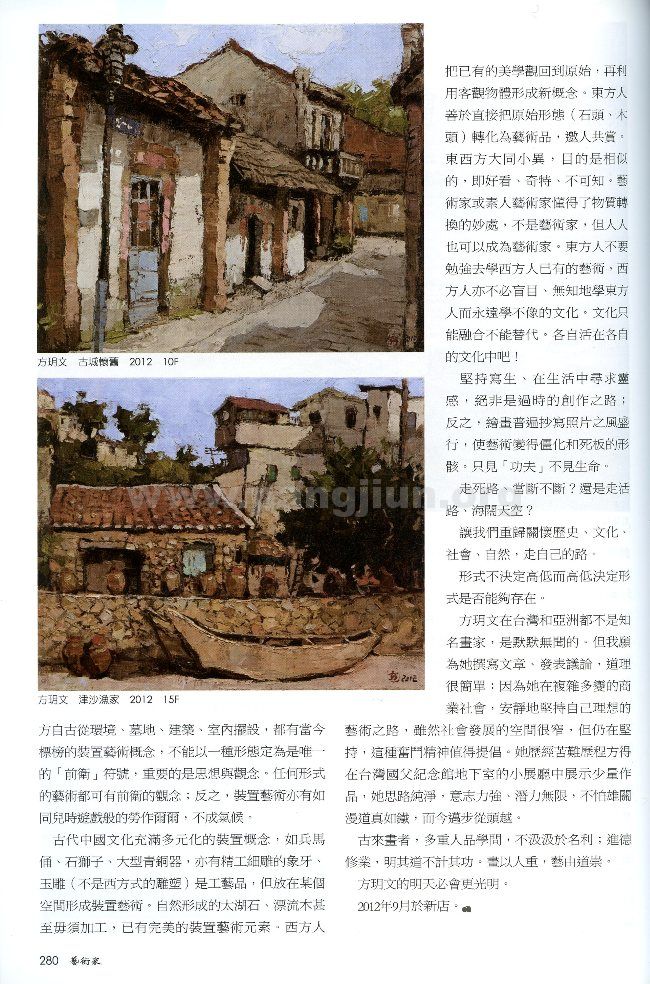 CLOSE
CLOSE
Trained not in a professional art academy, the female painter Fang Yue-wen became a teacher upon graduating from a university. However, her passion for art, especially her diligent study of painting, grants her more learning and cultivation than ordinary art students, while her upbringing in Tainan endows her with the cordiality and prudence characterizing the Southern Taiwanese. They distinguish her from a majority of art practitioners who are generally presumed to have inferior school performance and deficient family education besides drawing and sporting, and whose petty cleverness unpolished by wisdom turns them into more an artisan than a painter. It reminds me of my father who, despite an adoration of art since childhood, enrolled first in a medical program, and then in a Paris university, during which he begun to study painting in an artist’s studio. More progressive and congenial with the modern art movements than his contemporaries, and having a father who was a scholar, a grandfather and a great uncle who were Jinshis, and a great grandfather who was a Tanhua, he was one of the most knowledgeable and verbally versatile artists among the first-generation Taiwanese artists in France. Aside from painters, contributed to the aura of his art world were literary figures, poets, musicians, playwrights, archaeologists, choreographers, actors, and other foreign friends. Nevertheless, as the saying goes, “Enlightenment has no distinct doors,” one must struggle on the road of art alone to attain self-discipline and enlightenment. Practice is the prerequisite of self-accomplishment and successful expression.
In Taiwan, there are but a handful of female oil painters, much less influential ones. However, as far as I can see, some of them are gaining their foothold in their mid career, as age and experience accumulate. Work, teaching, and art creation do not hinder their pursuit of innovations and aesthetics of one’s own; neither are they trapped by the vulgarity and mediocrity of everyday life. Rare in number and less famed as their are (commercial fame is in fact of no importance), their achievements have been paving way for their future success on the international art scene. Yue-wen belongs to the group who is consistently striving for success based on creativity and individual style.
In my more than twenty years of teaching, I have seen a lot of talented female artists who ended up disappearing from the art circle in Taiwan entirely. What prevent them from establishing a life-long art career are mainly marriage and child-raising. Once I asked students, “What do you want to do after graduation?” Most of them answered, “Marry.” Alas! It reveals the low confidence of art students generally, and the failure of educational system in Taiwan!
Among my numerous female students, Yue-wen is indeed a distinct example. As mentioned above, due to her relatively superior cultivation, she was quick to learn the basic skills of painting. After a year in the studio, she easily passed the entrance examination to the master’s program of the Department of Fine Arts, National Taiwan Normal University, and graduated later with exceptional grades. In the more than ten years of dedication to art, she never applies any grandiose rhetoric to advertise herself either on Facebook or other venues on the web, which is particularly praiseworthy in an age of advanced computer technology. Unfazed by the vulgarity of the market, she never depends on her relatives and friends for selling her paintings, or even brings it to mind. Her sole concern is the perfection of her art. Her insistence on displaying works in different venues for every exhibition contributes to the maturity of her painting style.
Undeniably, artists are liable to be trapped by the commercialization and vulgarity characterizing modern society. As one of the most serious obstacles to artistic success, it also leads to the colonized, subjugated state of Taiwan art. At a time when the cultural value of art is giving way to the increasingly emphasized ‘commercial value’ of art, when media hypes are corroding the creative mind, it becomes a trial of personality for artists strive for and by means of art.
An attentive view of Yue-wen’s paintings offers one a glimpse of her character. The guilelessness and sincerity embody both her personal and artistic styles. Realistic and unadorned in depiction, and steady and modest in color use, her works are mostly completed in outdoor sketching. Addressing history and life, they render an image of a meditating artist who sketches beyond frivolousness and airiness. The ‘spiritual content’ of landscapes is thus a manifestation of her mind in the moment of painting, which contributes to the pleasing charm of her oeuvre. Laboriously portrayed on site, the humanistic aura of the unpopulated houses and ancient alleys, the historical traces of the brick roofs of old houses shown in overview, and the beauty of the trees and trunks on the beach disclose a modern person’s perspective of and concern for the changing and vanishing landscapes, as well as their connection with our cultural tradition.
Least attention should be paid to the hollow, extremist view that “oil painting is dead,” that “oil panting is not the right way” for would-be artists, and that oil painting is nothing but “handicraft.” Oil painting has a history of six to seven hundred years in the West. As the most steadfast painting medium, oils has made the art of oil painting as enduring as the history of humans and the earth, which may last for another ten thousand years. However, for the past century, the Eastern oil paintings have been retracing the already trodden road of the Western form, achieving nothing more than imitation. Self-examination and breakthroughs should be made to transcend the dilemma and broaden our vision.
The so-called ‘contemporary art’ has a wide definition. Rather than exploring the forms and techniques by which artistic elements are expressed, it is engaged with the artistic transformation of the concerns of and reflection on issues including society, the environment, nature, humans, history, culture, and philosophy. No artist is ‘the authority’ in the respect.
The close tie between humans and Nature has had a dramatic change over time. However, despite the sharp difference of the ways we and our ancestors depend on and make use of Nature, and the tremendous alteration of Nature itself, the earth remains. Contemporary art is the attempt to combine the sentiment and philosophy of our cultural ancestors with the thoughts and feelings of modern people for an understanding of the world we live in. In the artistic metamorphosis, surface depiction is regarded as uninspired by contemporary philosophical thoughts.
Instead of being a new invention, the modern concept of ‘installation art’ has been present in the construction of the environment, cemetery, architecture, and interior decoration, in both East and West. Its ‘progressiveness’ lies more in its concept and ideas than in its form. As much as progressiveness exists in every forms of art, it is possible for an installation work to be immature and frivolous, like a child’s game.
The ancient Chinese culture is variegated with the concept of installation art. Aside from terracotta warriors, stone lions, and large-scale bronzes, craftworks such as the intricately carved ivory artifacts and jades (not the Western sculpture) also constitute installation works when placed in a certain space. The inartificial beauty of Taihu stone and drift wood are also fully qualified as instances of installation art. In contrast to the Western reconstruction of a new aesthetics out of existing objects, the Eastern artists are adept at transforming the natural forms (stone, wood, etc.) into enjoyable artworks directly. Despite the difference, however, what both the Western and the Eastern artists intend to complete are graceful, extraordinary, and unexplainable works. The ingenuous transformation makes artworks not only for professional and amateur artists, but also for outsiders. It is therefore not necessary for the Eastern artists to duplicate the Western art, or for the Western artists to blindly follow the Eastern aesthetics. Culture can only be mixed, not replaced. One can only live in one’s own culture!
It is absolutely not outdated for an artist to sketch and seek inspirations from everyday life; meanwhile, copying of photographs as a method prevalent in today’s paintings leads to the demise and mummification of art, as they display more ‘craftsmanship’ than life.
To continue to struggle in the blind alley? Or to turn to an expansive vision?
Let us trace the steps of our history, culture, society, and nature, for a road of our own.
Form is not the determinant of value; on the contrary, it is value that determines whether the form is appropriate.
Yue-wen is not a famous painter either in Taiwan or Asia. Her relative anonymity, however, does not prevent me from writing this article and commentaries for her. The reason is simple: because she has persevered in her pursuit of art in the complex and shifty commercial world. Her perseverance is particularly inspiring in a society leaving limited space for art. This exhibition in the small basement gallery of the National Dr. Sun Yat-sen Memorial Hall is a result of her ceaseless, strenuous efforts. Few as the paintings exhibited may be, they disclose her purity, strong will, and potential. Hard trials may abound, but she has determined to strive to the end.
In ancient times, painters’ personality and knowledge are much emphasized. Less zealous for fame and profit, they endeavor to cultivate their mind and learning, measuring their achievements by no other means than morality and justice. Their personality gives weight for their paintings; their sense of morality gives prestige to their art.
Akin to the spirit of the ancient painters, Fang Yue-wen is destined to have a bright future.
September, 2012, in Xindian


